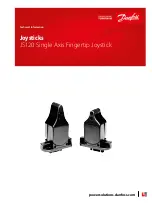
5 of 18
Specifications subject to change without notice
Edition: August 2017
Maintenance EB 31a-01_EN
Air supplied to port 2 (Fig. 5) forces the pistons apart and
towards the end positions. Air is vented at port 4. This is
based on a clockwise direction of rotation.
Air supplied to port 4 (Fig. 6) forces the pistons together. Air
is vented at port 2. This is based on a clockwise direction of
rotation.
•
Single-acting actuator
(standard direction of rotation)
Fig. 7
Fig. 8
Air supplied to port 2 (Fig. 7) forces the pistons apart and
towards the end positions. The springs are compressed. Air is
vented at port 4. This is based on a clockwise direction of
rotation.
A loss of air pressure at port 2 (Fig. 8) allows the pistons to
return to the start position. Air is vented at port 2. This is
based on a clockwise direction of rotation.
5.2
Important safety instructions
• For safety reasons, the actuator must not be pressurized
when mounting the actuator onto the valve. Risk of injury.
• When connecting the air pressure to the actuator, it is
important that all connecting parts are clean and free from
dirt, especially the thread connections, pipe screw fittings,
and gaskets.
• When fitting accessories to the actuator, make sure that
the emergency operator control of the solenoid valve and
the top end of the shaft are easily accessible for possible
manual operation of the actuator.
• Before mounting the actuator onto the valve, make sure
that the actuator is correctly aligned based on the direction
of rotation required.
• For single-acting actuators, make sure dangerous and/or
corrosive substances in the working environment cannot
enter the spring chambers through the use of suitable
filters and/or solenoid valves.
• Remove plugs from the actuator’s pneumatic connections
during installation and operation. Protect any unused
pneumatic connections of actuators.
5.3
Control and connections:
Fig. 9 – Connections
5.4
Mounting accessories
Fig. 10 - Mounting accessories
•
Mounting the solenoid valve:
Before mounting the solenoid valve, check that the
actuator is in the initial position (closed position, pistons
retracted). For standard mounting and clockwise rotation
(closing): The groove on the shaft or position indicator (2)
must be in the closed position, at a right angle to the
longitudinal axis of the actuator. Mount the solenoid valve
(4) onto the actuator (3) using the suitable screws (see
Table 2 for max. tightening torque).
•
Mounting the limit switch box:
Fit the limit switch box and bracket (1) onto the actuator
(3) using suitable screws (see Table 2 for max. tightening
torque).
Screw
M5 M6 M8 M10 M12 M14 M16 M20 M24 M30
Tightening
torque
in NM
5
bis
6
10
bis
11
23
bis
25
48
bis
52
82
bis
86
132
bis
138
200
bis
210
390
bis
410
675
bis
705
1340
bis
1400
Table 2 - Tightening torque




































